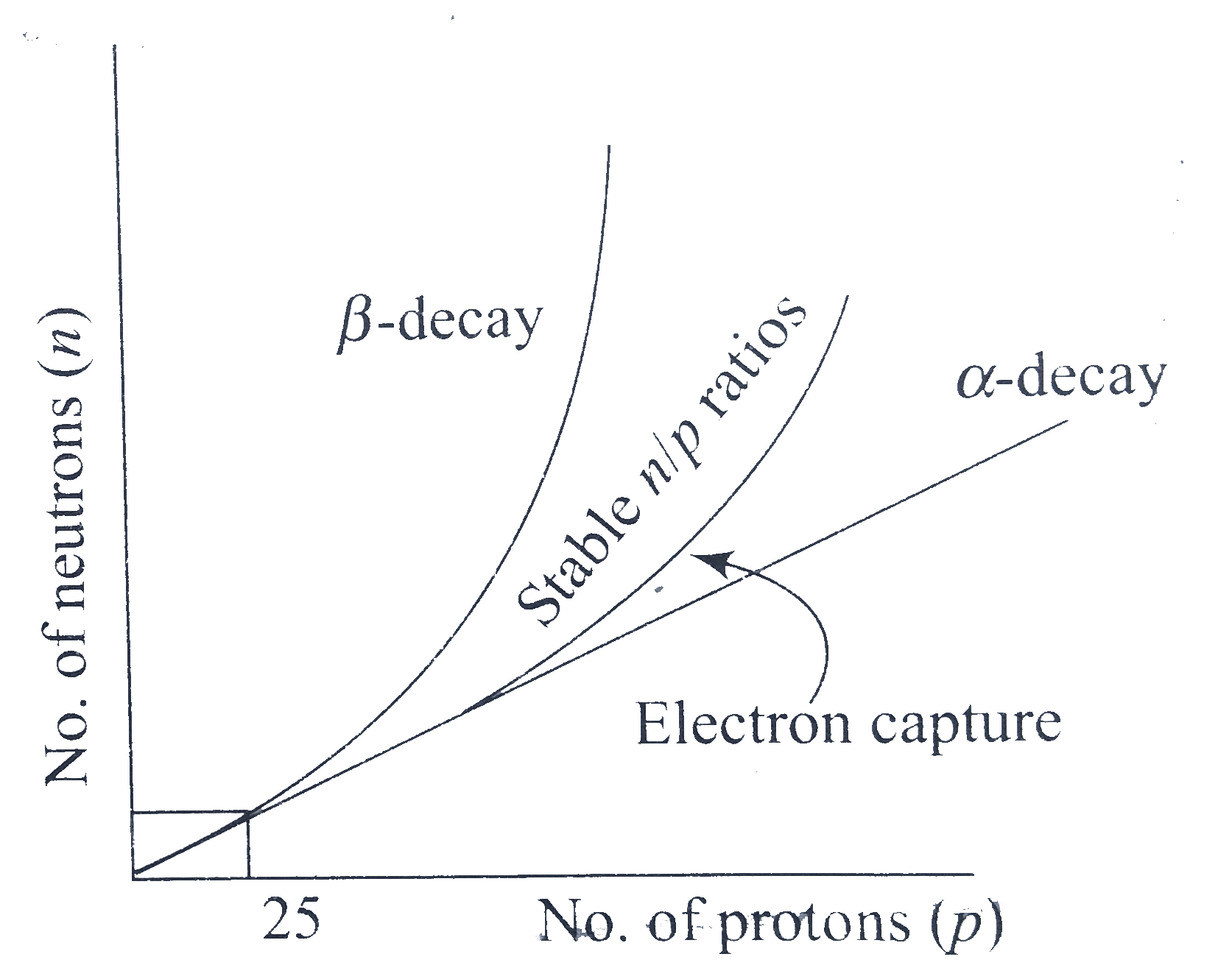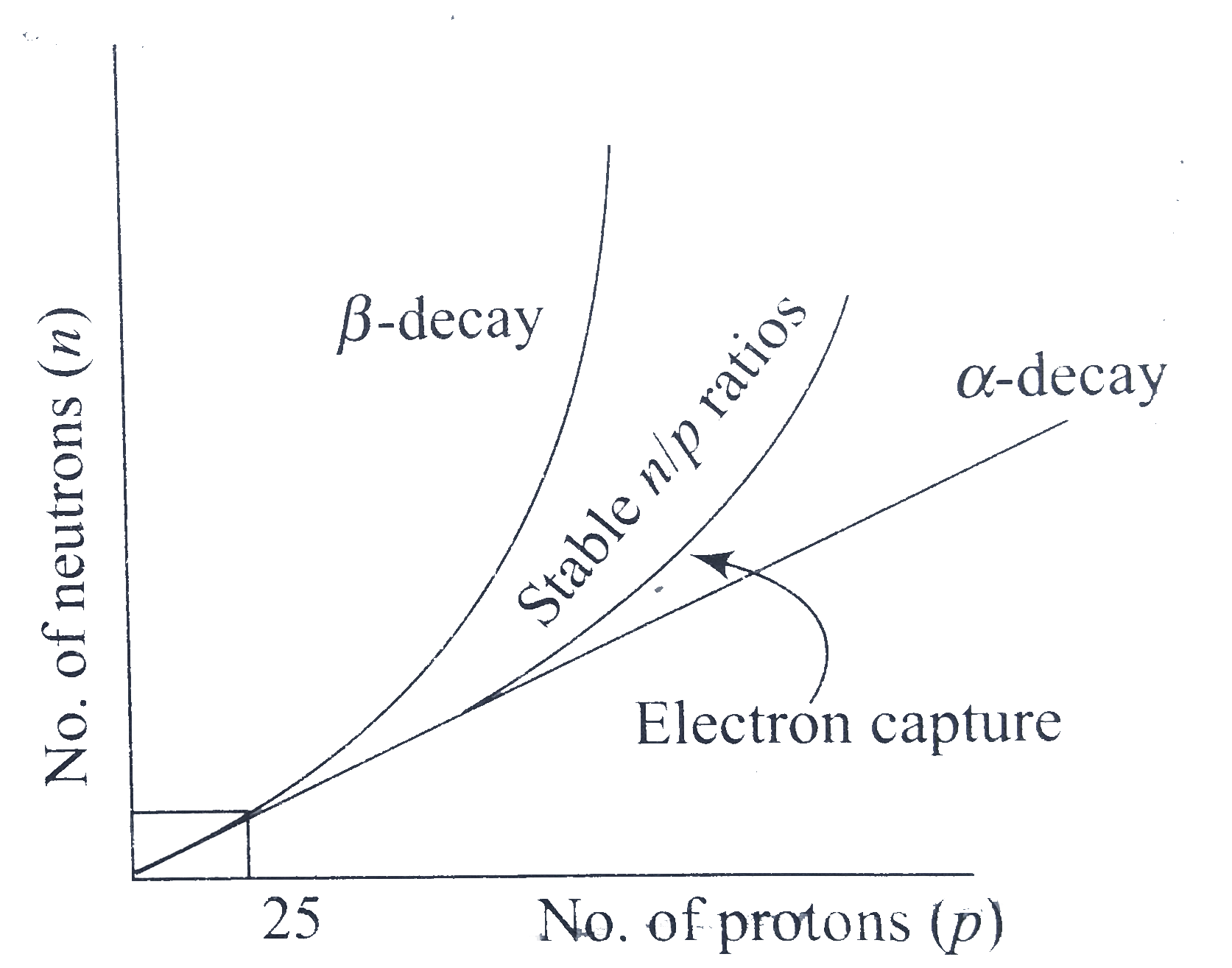Statement : The plot of atomic number ( y -axis ) versus number of neutrons ( x -axis ) for stable nuclei shows a curvature towards x-axis fron the line of 45∘ slope as the atomic number is increased .
Explanation : proton -proton electrostatic repulsions begin to overcome attracive forces involving protons and neutrons in heavier nuclides.
If both (A) and (R ) are correct, and (R ) is the correct explanation of (A).
If both (A) and (R ) are correct, but (R ) is not the correct explanation of (A)
If (A) is correct, but (R ) is incorrect.
If (A) is incorrect, but (R ) is correct
The correct Answer is:A
To solve the given question step by step, we will analyze the statement and explanation provided, and then determine their correctness.
Step 1: Understand the Statement
The statement claims that when plotting atomic number (on the y-axis) against the number of neutrons (on the x-axis) for stable nuclei, the curve shows a downward curvature towards the x-axis from a line with a slope of 45 degrees as the atomic number increases.
Step 2: Draw the Graph
1. Axes Setup: Draw a graph with the y-axis representing the atomic number (Z) and the x-axis representing the number of neutrons (N).
2. 45-degree Line: Initially, draw a straight line at a 45-degree angle. This line represents a scenario where the number of protons equals the number of neutrons (Z = N).
3. Curvature: Now, observe that as we move to heavier nuclei (higher atomic numbers), the curve bends downwards towards the x-axis. This indicates that the number of neutrons increases more rapidly than the number of protons in stable nuclei.
Step 3: Analyze the Explanation
The explanation states that this curvature occurs because proton-proton electrostatic repulsions begin to overcome the attractive forces involving protons and neutrons in heavier nuclides.
Step 4: Evaluate the Correctness
1. Correctness of the Statement: The statement is correct. The observed curvature indeed indicates that as atomic number increases, the ratio of neutrons to protons changes, leading to stability in heavier nuclides.
2. Correctness of the Explanation: The explanation is partially correct but not entirely accurate. While it is true that proton-proton repulsion increases with more protons, the primary reason for the curvature is to achieve stability through a higher number of neutrons relative to protons. Thus, the explanation does not fully capture the reason for the observed behavior.
Step 5: Conclusion
Based on the analysis:
- The statement is correct.
- The explanation is incorrect.
Final Answer
The correct option is that the assertion (statement) is true, but the reason (explanation) is false.
---
The statement claims that when plotting atomic number (on the y-axis) against the number of neutrons (on the x-axis) for stable nuclei, the curve shows a downward curvature towards the x-axis from a line with a slope of 45 degrees as the atomic number increases.
1. Axes Setup: Draw a graph with the y-axis representing the atomic number (Z) and the x-axis representing the number of neutrons (N).
2. 45-degree Line: Initially, draw a straight line at a 45-degree angle. This line represents a scenario where the number of protons equals the number of neutrons (Z = N).
3. Curvature: Now, observe that as we move to heavier nuclei (higher atomic numbers), the curve bends downwards towards the x-axis. This indicates that the number of neutrons increases more rapidly than the number of protons in stable nuclei.
The explanation states that this curvature occurs because proton-proton electrostatic repulsions begin to overcome the attractive forces involving protons and neutrons in heavier nuclides.
1. Correctness of the Statement: The statement is correct. The observed curvature indeed indicates that as atomic number increases, the ratio of neutrons to protons changes, leading to stability in heavier nuclides.
2. Correctness of the Explanation: The explanation is partially correct but not entirely accurate. While it is true that proton-proton repulsion increases with more protons, the primary reason for the curvature is to achieve stability through a higher number of neutrons relative to protons. Thus, the explanation does not fully capture the reason for the observed behavior.
Based on the analysis:
- The statement is correct.
- The explanation is incorrect.
The correct option is that the assertion (statement) is true, but the reason (explanation) is false.
Topper's Solved these Questions
- NUCLEAR CHEMISTRYBOOK - CENGAGE CHEMISTRY ENGLISHCHAPTER - NUCLEAR CHEMISTRYEXERCISE - Archives Integer-Type
1 Video
- NUCLEAR CHEMISTRYBOOK - CENGAGE CHEMISTRY ENGLISHCHAPTER - NUCLEAR CHEMISTRYEXERCISE - Archives Fill In The Blanks
5 Videos
- NUCLEAR CHEMISTRYBOOK - CENGAGE CHEMISTRY ENGLISHCHAPTER - NUCLEAR CHEMISTRYEXERCISE - Archives Single Correct Anser
9 Videos
- NCERT BASED EXERCISEBOOK - CENGAGE CHEMISTRY ENGLISHCHAPTER - NCERT BASED EXERCISEEXERCISE - Nuclear Chemistry (NCERT Exercise)
29 Videos
- ORGANIC COMPOUNDS WITH FUNCTIONAL GROUPBOOK - CENGAGE CHEMISTRY ENGLISHCHAPTER - ORGANIC COMPOUNDS WITH FUNCTIONAL GROUPEXERCISE - Archives Analytical And Descriptive
24 Videos
Similar Questions
A plot of the number of neutrons (n) against the number of protons (p) of stable nuclei exhibits upward deviation from linearity for atomic number, Z>20. For an unstable nucleus having n/p ratio less than 1, the possible mode (s) of decay is (are)
View SolutionStatement-1:Light nuclei having equal number of protons and neutrons are more stable
Statement-2:In heavy nuclei, there is an excess of neutrons due to comlomb repulsion between protons .
View SolutionSulphur has an atomic number 16 and a mass number of 32. State the number of protons and neutrons in the nucleus of sulphur. Give a simple diagram to show the arrangement of electrons in an atom of sulphur.
View SolutionIf the atomic number (Z) and mass number (A) of an element X are related by the equation A+Z= 46 and the total number of neutrons in one atom of X is 16, then the total number of protons and electrons in one atom of element X='a'. Find value of 'a'
View SolutionStatement I:Heavy nuclides tend to have more number of neutrons than protons.
Staements II: In hevay nuclei, as there is coloumbic repulsion between protons, so excess of neutrons are preferable:
View SolutionUnstable nuclei attain stability through disintegration. The nuclear stability is related to neutron proton ratio (n/p). For stable nuclei n/p ratio lies close to unity for elements with low atmoic numbers (20 or less) but it is more than 1 for nuclei having higher atomic numbers. Nuclei having n/p ratio either very high or low undergo nuclear transformation. When n/p ratio is higher than required for stability, the nuclei have the tendency to emit β-rays. while when n/p ratio is lower than required for stability, the nuclei either emits α-particles or a positron or capture K-electron.
For reaction .92M238→.yNx+2.2He4,.yNx→.BLA+2.−1e0
The number of neutrons in the element L is
View SolutionVarious rules of thumb have seen proposed by the scientific community to expalin the mode of radioactive decay by various radioisotopes. One of the major rules is called the n/p ratio. If all the known isotopes of the elemnts are plotted on a graph of number of neutrons (n) versus number of protons (p), it is observed that all isotopes lying outside of a ''stable'' n/p ratio region are radioactive as shown fig. The graph exhibits straight line behaviour with unit slope up to p=25. Above p=25, tgose isotopes with n/p ratios lying above the stable region usually undergo beta decay. Very heavy isotopes (p>83) are unstable because of their relativley large nuclei and they undergo alpha decay. Gamma ray emission does not involve the release of a particle. It represnts a change in an atom from a higher energy level to a lower energy level.

How would the radioisotope of magnesium with atomic mass 27 undergo radioactive decay?.
View SolutionUnstable nuclei attain stability through disintegration. The nuclear stability is related to neutron proton ratio (n/p). For stable nuclei n/p ratio lies close to unity for elements with low atmoic numbers (20 or less) but it is more than 1 for nuclei having higher atomic numbers. Nuclei having n/p ratio either very high or low undergo nuclear transformation. When n/p ratio is higher than required for stability, the nuclei have the tendency to emit β-rays. while when n/p ratio is lower than required for stability, the nuclei either emits α-particles or a positron or capture K-electron.
Unstalbe substance exhibit high radioactivity due to
View SolutionVarious rules of thumb have seen proposed by the scientific community to expalin the mode of radioactive decay by various radioisotopes. One of the major rules is called the n/p ratio. If all the known isotopes of the elemnts are plotted on a graph of number of neutrons (n) versus number of protons (p), it is observed that all isotopes lying outside of a ''stable'' n/p ratio region are radioactive as shown f The graph exhibits straight line behaviour with unit slope up to p=25. Above p=25, tgose isotopes with n/p ratios lying above the stable region usually undergo beta decay. Very heavy isotopes (p>83) are unstable because of their relativley large nuclei and they undergo alpha decay. Gamma ray emission does not involve the release of a particle. It represnts a change in an atom from a higher energy level to a lower energy level.

Th−230 undergoes a series of radioactive decay processes resulting in Bi−214 being the final product. What was the sequence of the processes that occured?
View SolutionStaements I: Light nuclei are most stable if N =Z, while heavy nuclei are more stable if N > Z. (N→ number of neutrons, Z→ number of protons)
Staements II: As the number of protons increases in a nucleus, the Coulomb's repulsive forece increases, which tends to break the nucleus apart. So, to keep the nucleus apart. So, to keep the nucleus stable, more number of neutrons are needed which are neutral in nature.
View Solution